Workshop Lifting Cranes: A Comprehensive Guide for Users and Buyers
Workshop Lifting Cranes: A Comprehensive Guide for Users and Buyers
Welcome to the world of Workshop Lifting Cranes! If your operations involve heavy materials or equipment, you're about to discover a game-changing solution that can revolutionize your efficiency, safety, and productivity. In this comprehensive guide, we'll embark on a journey to master the art of workshop lifting cranes – the unsung heroes of modern industry.
The Crucial Role of Workshop Lifting Cranes
Imagine a bustling workshop or manufacturing facility where heavy loads need to be moved, lifted, or transported across the workspace. This is where workshop lifting cranes come into play. They are the backbone of efficient material handling, making the seemingly impossible tasks achievable with ease.
Workshop lifting cranes are the giants that lift and carry the heavyweights, making your daily operations smoother and safer. These machines are precision-engineered for one primary purpose: to simplify the intricate task of handling substantial loads. Whether you're in manufacturing, construction, warehousing, or any industry that deals with heavy objects, understanding the fundamentals of workshop lifting cranes is a game-changer.
Exploring the Types of Workshop Lifting Cranes
Welcome back to our comprehensive guide on mastering workshop lifting cranes. In this section, we'll embark on a journey to explore the world of specialized crane types. Each type is uniquely designed to cater to specific needs and constraints, offering a wide range of applications across various industries. Let's dive in and unveil the differences, features, and advantages of each.
Single-Girder vs. Double-Girder Cranes: Unveiling the Differences
The battle of the giants: Single-Girder vs. Double-Girder Cranes. These two stalwarts are often the cornerstone of material handling in many industries. But how do they differ, and when should you choose one over the other?
- Single-Girder Cranes: These cranes are known for their simplicity, cost-effectiveness, and ease of installation. They are ideal for lighter loads and lower headroom applications. We'll explore their advantages and typical use cases.
- Double-Girder Cranes: When it comes to heavy lifting and increased spans, double-girder cranes take center stage. They offer higher capacity and better stability, making them indispensable in demanding industrial settings. Discover when to opt for this powerhouse.
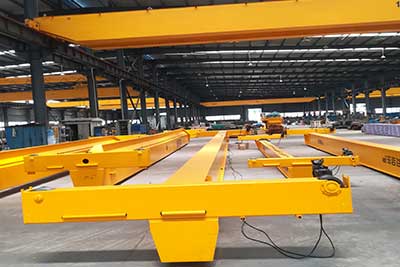
Unique Features:
- Single horizontal girder on the bridge.
- Versatile and cost-effective.
- Ideal for light to medium-duty lifting.
Benefits:
- Efficient material handling in small to mid-sized facilities.
- Maximizes workspace utilization.
- Suited for manufacturing, warehousing, and maintenance tasks .
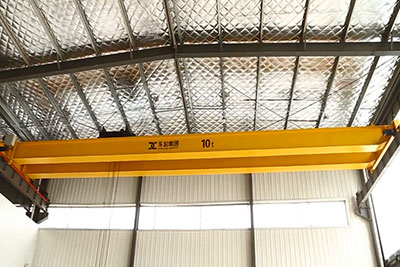
Unique Features:
- Two parallel girders on the bridge.
- Exceptional lifting capacity.
- Suitable for heavy-duty applications.
Benefits:
- Handles heavy loads with ease.
- Perfect for steel manufacturing, automotive, and shipbuilding .
- Enhanced stability and durability.
Cranes Applications
- Manufacturing Excellence: On the manufacturing floor, single-girder cranes reign supreme. They effortlessly move materials from one workstation to another, ensuring seamless production processes. Whether you're assembling automobiles, fabricating steel structures, or crafting precision instruments, these cranes enhance efficiency and precision.
- Maintenance and Repairs: Single-girder cranes are valuable assets in maintenance and repair facilities. They help with the safe removal and installation of heavy equipment, making routine maintenance tasks faster and safer.
- Small Workshops: Even in smaller workshops, single-girder cranes have their place. They can handle a wide range of loads, from smaller components to substantial machinery, making them indispensable in various manufacturing and repair settings.
Gantry Cranes: The Powerhouses of Versatility
Gantry cranes, often called bridge cranes, are the epitome of versatility. These mobile lifting machines can traverse large distances while carrying substantial loads. They're your answer to flexibility in material handling. Join us as we delve into the world of gantry cranes and their countless applications.
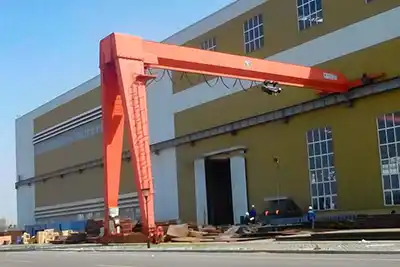
Single Leg Gantry Cranes
Supported by a single vertical leg on each side, they excel in outdoor settings such as construction sites, shipyards, and lumber yards.
Single leg gantry cranes are a type of overhead crane that has only one supporting leg. They are used for lifting and moving heavy loads in a variety of industries.
Features of single leg gantry cranes:
- Single supporting leg for compact design and ease of movement
- Can be customized with different hoist and trolley configurations to meet specific lifting needs
- Can be powered by electricity, diesel, or other fuel sources
Benefits of single leg gantry cranes:
- Require less space than double leg gantry cranes, making them useful in facilities with limited space
- Easier to move around due to the single supporting leg
- Can be more cost-effective than double leg gantry cranes
Applications for single leg gantry cranes include manufacturing, construction, mining, and transportation. They are especially useful in areas where space is limited or where a forklift or other equipment cannot reach. They can also be used for outdoor lifting and moving operations.

Double Leg Gantry Cranes
Also known as full gantry cranes, they boast two vertical support legs on each side, providing exceptional stability and capacity. They are suitable for both indoor and outdoor applications.
Double leg gantry cranes are a type of overhead crane that has two supporting legs. They are used for lifting and moving heavy loads in a variety of industries.
Features of double leg gantry cranes:
- Two supporting legs for greater stability
- Can handle heavier loads than single leg gantry cranes
- Can cover a larger area than single leg gantry cranes
- Can be customized with different hoist and trolley configurations to meet specific lifting needs
- Can be powered by electricity, diesel, or other fuel sources
Benefits of double leg gantry cranes:
- More stable than single leg gantry cranes, reducing the risk of accidents
- Can handle heavier loads, making them suitable for larger-scale lifting operations
- Can cover a larger area, making them useful in facilities with multiple workstations
- Can be customized to meet specific lifting needs, increasing efficiency and productivity
Gantry Cranes Applications
- Warehousing Marvels: Warehouses are hubs of constant activity, and gantry cranes are the superheroes of material handling within these spaces. They efficiently load and unload goods, stack pallets, and transport heavy items across the facility. Versatility is their middle name, adapting to the ever-changing demands of the logistics industry.
- Construction Sites: Construction sites require robust lifting solutions, and gantry cranes step up to the challenge. They assist in erecting structural elements, placing heavy materials at precise locations, and enhancing efficiency during the construction process.
- Shipyard Giants: In shipyards, where mammoth vessels come to life, gantry cranes play an essential role. They move ship sections and components with ease, ensuring smooth assembly and maintenance.
Jib Cranes: Precision in a Compact Form
In tight spaces where maneuverability is paramount, jib cranes take the spotlight. These compact lifting solutions are known for their precision and ease of use. From assembly lines to workshops, we'll unveil where jib cranes shine and why they're a preferred choice.
Jib Crane Applications
- Assembly Lines: Precision is key on assembly lines, and jib cranes excel in this environment. They assist in the precise placement of components, making it easier for workers to assemble products with accuracy and speed.
- Machine Shops: In machine shops, jib cranes facilitate the lifting of heavy machinery and components, allowing for efficient maintenance, repairs, and tool changes.
- Loading Docks: Jib cranes at loading docks expedite the unloading and loading of goods from trucks, enhancing the overall throughput of goods distribution centers.
Wall-Mounted Cranes: Saving Space, Boosting Efficiency
Floor space is often at a premium, and that's where wall-mounted cranes come to the rescue. These space-saving wonders are attached to existing structures, optimizing your workspace without compromising on lifting capacity. Learn how they're making efficient use of every inch in workshops and factories.
The Space-Saving Solution of Wall Mounted Cranes
- Automotive Workshops: Automotive workshops often have limited floor space. Wall-mounted cranes are the perfect solution for these settings, efficiently lifting and moving engines, transmissions, and other heavy automotive components.
- Small Manufacturing Units: In small manufacturing units, wall-mounted cranes are space-saving workhorses. They can be installed close to workstations, reducing the need for extensive floor space.
- Tool and Die Shops: Wall-mounted cranes are valuable assets in tool and die shops, where they assist in handling heavy molds, dies, and tools with ease and precision.
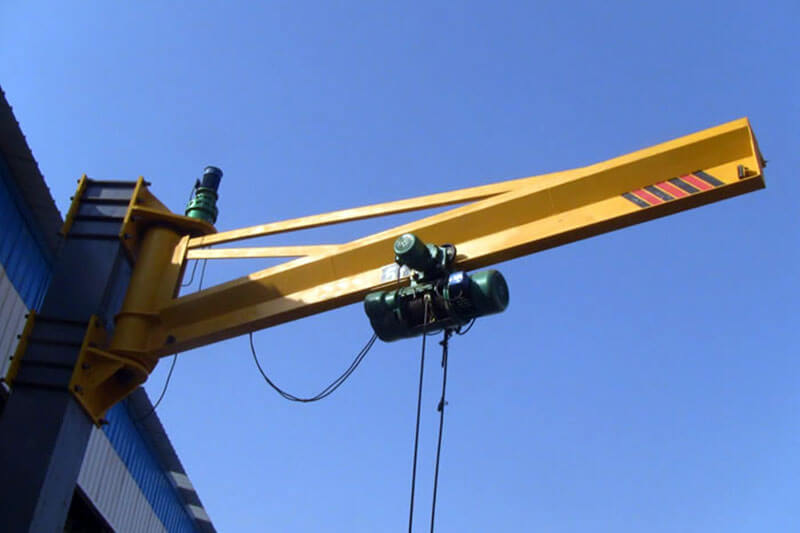
Wall-Mounted Jib Cranes:
These cranes are attached to walls and are commonly seen in workshops and manufacturing cells.
Wall mounted jib cranes are a type of jib crane that is mounted on a wall or column. They are used for lifting and moving loads in a smaller area.
Features of wall mounted jib cranes:
- Can be mounted on walls or columns, saving floor space
- Can rotate 180 degrees, providing greater coverage
- Can be customized with different hoist and trolley configurations to meet specific lifting needs
- Can be powered by electricity, air, or other sources
Benefits of wall mounted jib cranes:
- Save floor space, making them useful in facilities with limited space
- Can rotate 180 degrees, providing greater coverage than floor mounted jib cranes
- Can be more cost-effective than other types of cranes
- Easy to install and maintain
Applications for wall mounted jib cranes include manufacturing, warehouses, and assembly lines. They are especially useful for lifting and moving loads in a smaller area, such as loading and unloading materials from machines or transporting materials between workstations. They can also be used for outdoor lifting and moving operations.
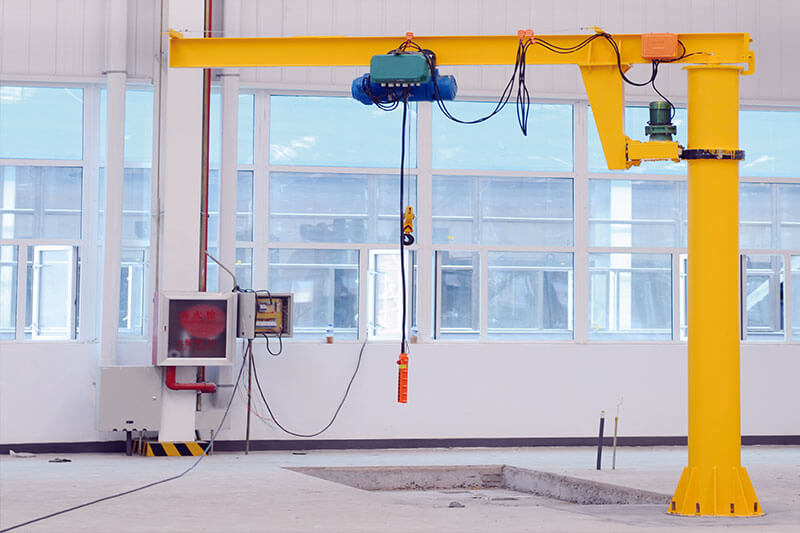
Floor-Mounted Jib Cranes:
Anchored to the floor, they offer increased lifting capacity and range, making them versatile for various tasks.
Floor mounted jib cranes are a type of jib crane that is mounted on a floor or foundation. They are used for lifting and moving loads in a smaller area.
Features of floor mounted jib cranes:
- Can be easily moved around the floor as needed
- Can rotate 360 degrees, providing complete coverage
- Can be customized with different hoist and trolley configurations to meet specific lifting needs
- Can be powered by electricity, air, or other sources
Benefits of floor mounted jib cranes:
- Can be used in facilities with limited space
- Can rotate 360 degrees, providing complete coverage of the work area
- Can be more cost-effective than other types of cranes
- Easy to install and maintain
Applications for floor mounted jib cranes include manufacturing, warehouses, and assembly lines. They are especially useful for lifting and moving loads in a smaller area, such as loading and unloading materials from machines or transporting materials between workstations. They can also be used for outdoor lifting and moving operations.
As we explore each crane type, you'll gain a deeper understanding of their strengths and applications. Whether you need to maximize capacity, increase mobility, or save space, there's a workshop lifting crane type perfectly suited for your requirements.
In the upcoming section, we'll investigate the standout features that elevate these cranes to new heights of efficiency, precision, and safety. So, stay tuned as we continue our journey through the world of workshop lifting cranes.
Workshop Lifting Cranes: Features that Elevate Your Operations
Empowering Efficiency, Safety, and Precision
Welcome back to our in-depth guide on workshop lifting cranes. In this section, we'll unveil the extraordinary features that transform these lifting machines into indispensable tools for your operations. From precision control to customized solutions and top-notch safety features, workshop lifting cranes are engineered to enhance every facet of your material handling processes.
Precision Control: Where Safety Meets Efficiency
In the world of material handling, precision is paramount. Workshop lifting cranes are engineered with cutting-edge control systems that strike a perfect balance between safety and efficiency. Here's why precision control matters:
- Safety: Safety is non-negotiable in any workspace. Workshop lifting cranes are equipped with advanced control mechanisms that ensure safe load handling, preventing accidents and injuries.
- Efficiency: Precision control allows for smooth and accurate positioning of heavy loads. This not only speeds up your operations but also minimizes the risk of product damage or mishaps.
From intuitive control panels to remote operation options, these cranes give you the power to move heavy materials with pinpoint accuracy, all while maintaining the highest safety standards.
Customization: Tailoring Cranes to Your Unique Needs
No two workshops or industrial settings are identical, and neither should your lifting equipment be. Workshop lifting cranes are designed with customization in mind, offering a range of options to suit your unique requirements:
- Load Capacity: Whether you're lifting a few hundred pounds or several tons, there's a crane with the perfect load capacity for your needs.
- Span: The span of the crane can be tailored to match your workspace dimensions, ensuring maximum coverage and efficiency.
- Control Options: Choose the control interface that suits your preferences, from traditional pendant controls to advanced remote systems.
- Additional Features: Workshop lifting cranes can be equipped with additional features such as operator cabins, anti-collision systems, and more, all designed to enhance usability.
By tailoring your crane to your specific needs, you're not just investing in equipment; you're investing in operational excellence.
Safety First: Built-In Features to Protect Your Team
Safety is the bedrock of any successful operation, and workshop lifting cranes are built with this principle at their core. These machines come equipped with a suite of built-in safety features:
- Limit Switches: These devices prevent the crane from over-traveling, ensuring it stops at the designated endpoints.
- Overload Protection: Sensors detect excessive loads and automatically cut power to prevent overloading, safeguarding both your equipment and personnel.
- Emergency Stop: In case of an unforeseen situation, an emergency stop button allows for immediate shutdown, minimizing risks.
- Warning Signals: Visual and auditory warnings alert operators to potential hazards, enhancing overall safety awareness.
Incorporating these safety features into the design of workshop lifting cranes not only protects your team but also safeguards your investments by reducing the likelihood of accidents and equipment damage.
As we delve further into this guide, we'll explore the myriad benefits that these features bring to your operations, from increased productivity to enhanced safety and beyond. So, stay with us as we continue our journey through the world of workshop lifting cranes.
Benefits of Workshop Lifting Cranes
Elevating Your Operations to New Heights
Welcome back to our comprehensive guide on workshop lifting cranes. In this section, we're going to explore the myriad benefits that these incredible machines bring to your operations. From improved productivity to space optimization and enhanced safety, workshop lifting cranes offer a wide array of advantages that can transform the way you handle materials.
Improved Productivity: The Crane Advantage
Efficiency and productivity are the lifeblood of any operation, and workshop lifting cranes are the secret weapon to achieving these goals. Here's how they enhance productivity:
- Speed: Workshop lifting cranes can swiftly move heavy loads from one point to another, reducing the time it takes to complete tasks.
- Precision: Precision control allows for accurate positioning of materials or equipment, eliminating the need for time-consuming manual adjustments.
- Reduced Labor: With a crane doing the heavy lifting, your workforce can focus on more skilled and value-added tasks, increasing overall productivity.
- Continuous Operation: Cranes can operate continuously, 24/7 if necessary, ensuring that your production or material handling processes never stop.
By streamlining material handling processes and reducing downtime, workshop lifting cranes become catalysts for achieving higher productivity levels.
Space Optimization: Maximizing Your Workspace
Workspaces are valuable real estate, and workshop lifting cranes are masters at optimizing them. Here's how they make the most of your available space:
- Floor Space: Wall-mounted cranes, gantry cranes, and jib cranes are designed to minimize their footprint, freeing up valuable floor space for other operations or storage.
- Coverage: Workshop lifting cranes can span large areas, maximizing your workspace by reaching every nook and cranny.
- Versatility: Gantry cranes, in particular, can be easily moved around, adapting to changing layouts and demands.
By making efficient use of your workspace, these cranes open up new possibilities for layout design and operational efficiency.
Enhanced Safety: Minimizing Risks in Material Handling
Safety is paramount in any workplace, and workshop lifting cranes are designed with safety as a top priority. Here's how they minimize risks in material handling:
- Load Stability: Cranes provide secure and stable handling of loads, reducing the risk of accidents due to shifting or falling objects.
- Operator Safety: Modern control systems and safety features protect crane operators, ensuring they can work confidently and without undue risks.
- Reduced Manual Handling: By taking the strain of heavy lifting away from human workers, cranes minimize the risk of musculoskeletal injuries.
- Emergency Features: Built-in safety mechanisms such as limit switches, overload protection, and emergency stop buttons ensure quick responses to potential hazards.
Investing in workshop lifting cranes isn't just about enhancing productivity; it's also about creating a safer working environment for your team.
As we progress through this guide, we'll continue to uncover the value that workshop lifting cranes bring to your operations. Stay tuned as we explore their typical applications and dive deeper into real-world scenarios where these machines shine.
Typical Industrial Applications of Workshop Lifting Cranes
In this section, we'll explore the pivotal role that workshop lifting cranes play in two major industrial applications: manufacturing excellence and warehousing solutions. These cranes are not just tools; they are essential partners in achieving operational efficiency and success in these key sectors.
Manufacturing Excellence: Cranes on the Production Floor
- Automotive Manufacturing: In the fast-paced world of automotive production, precision and efficiency are paramount. Workshop lifting cranes, particularly single-girder and double-girder cranes, are the backbone of production floors. They handle the heavy lifting of vehicle components, ensuring seamless assembly lines and timely production.
- Single-Girder Cranes: These cranes excel in moving lighter components with precision. They are commonly found in automotive plants for tasks like engine installation and chassis assembly.
- Double-Girder Cranes: When it comes to handling substantial loads, double-girder cranes take center stage. In automotive manufacturing, they are indispensable for lifting car bodies and other weighty components.
- Aerospace Production: The aerospace industry demands the highest levels of precision and safety. Workshop lifting cranes play a pivotal role in handling large aircraft components, such as wings and fuselages. Their precise control systems ensure that critical parts are maneuvered into place with absolute accuracy.
- Heavy Machinery Fabrication: Manufacturers of heavy machinery, such as bulldozers and excavators, rely on workshop lifting cranes for the assembly of these industrial giants. Double-girder cranes are frequently used to handle the weight and size of these heavy components.
Warehousing Solutions: Streamlining Storage and Retrieval
- Logistics Centers: Gantry cranes are the workhorses of logistics centers and distribution hubs. They excel at loading and unloading goods from trucks and efficiently moving them to designated storage areas. Their ability to cover vast areas ensures that no storage space goes unused, enhancing overall logistics efficiency.
- Cold Storage Facilities: Temperature-sensitive goods in cold storage facilities require careful handling. Gantry cranes provide the precision needed to stack and retrieve these products without compromising quality. This is crucial for maintaining the integrity of perishable items.
- Distribution Warehouses: Jib cranes are indispensable at loading docks in distribution warehouses. They expedite the movement of goods, ensuring timely deliveries and reducing waiting times for transport vehicles. This efficiency is vital for meeting customer demands in a competitive market.
- In both manufacturing and warehousing, workshop lifting cranes are indispensable tools that streamline operations, increase efficiency, and contribute to overall success. They are the silent heroes behind the scenes, ensuring that products are manufactured with precision and delivered to customers' doorsteps on time.
Understanding Crane Cost and Price
In this section, we'll shed light on the financial side of workshop lifting cranes. Understanding the cost, price, and overall value of these powerful machines is crucial for making informed decisions that benefit your operations and your bottom line.
Factors Influencing Crane Cost
Investing in a workshop lifting crane is a strategic decision that requires consideration of various factors that influence the cost. Here are some key elements to keep in mind:
- Type and Capacity: The type of crane and its lifting capacity are primary cost determinants. Single-girder cranes, for instance, are generally more cost-effective than double-girder cranes, while higher lifting capacities typically come with a higher price tag.
- Customization: Tailoring the crane to your specific needs often incurs additional costs. Custom features, extended spans, or specialized attachments can impact the overall cost.
- Installation: The complexity of installation can affect costs. Wall-mounted cranes, for example, may have lower installation costs compared to gantry cranes, which require a more extensive setup.
- Maintenance Requirements: Consider the long-term maintenance needs of the crane. While initial costs are essential, ongoing maintenance costs should also be factored into your budget.
- Safety Features: Advanced safety features, such as anti-collision systems or remote monitoring, can add to the upfront cost but provide significant value in terms of safety and operational efficiency.
Understanding these factors allows you to make a well-informed decision that aligns with your budget and operational requirements.
The True Value of Workshop Lifting Cranes
While it's essential to consider the initial cost of a workshop lifting crane, it's equally crucial to recognize the long-term value they bring to your operations. Here's where the true value lies:
- Increased Productivity: Workshop lifting cranes significantly boost productivity by reducing material handling times and optimizing workflow. This increased output can translate into higher revenue and profitability.
- Space Utilization: Cranes maximize your workspace, allowing you to make the most of available real estate. This space optimization can lead to cost savings and operational efficiencies.
- Enhanced Safety: The safety features of workshop lifting cranes minimize the risk of accidents and injuries, reducing associated costs such as worker compensation claims and equipment damage.
- Longevity: Well-maintained cranes can serve your operations for decades, offering a solid return on investment over time.
- Competitive Advantage: Having efficient material handling capabilities can give your business a competitive edge, potentially leading to increased market share and revenue growth.
In essence, the true value of workshop lifting cranes extends far beyond the initial purchase price, making them a wise and strategic investment.
Budgeting for Efficiency: Balancing Cost and Benefits
Balancing your budget while optimizing efficiency is the key to a successful investment in workshop lifting cranes. Here's how to do it:
- Assess Your Needs: Begin by assessing your specific material handling requirements, considering factors such as load capacity, workspace layout, and safety considerations.
- Set a Budget: Determine your budget based on your needs and financial capabilities. Be sure to account for installation, customization, and ongoing maintenance costs.
- Evaluate Options: Explore various crane types and manufacturers to find the best fit for your budget and operational requirements. Don't compromise on quality or safety to cut costs.
- Consider ROI: Calculate the potential return on investment (ROI) based on increased productivity, reduced labor costs, and improved safety. This will help you make a well-informed decision.
- Plan for Maintenance: Factor in the long-term costs of crane maintenance and upkeep to ensure the crane continues to perform efficiently and safely.
By carefully balancing cost and benefits, you can make a strategic investment in workshop lifting cranes that not only meets your budget but also elevates your operations to new heights of efficiency and success. In the next section, we'll address the top concerns of workshop lifting crane users, providing insights into how to operate and maintain these machines safely and effectively.
Addressing User Concerns
In this section, we'll address the top concerns of workshop lifting crane users. Safety, maintenance, and operator training are critical aspects that ensure accident-free operations and extend the lifespan of these powerful machines.
Safety Precautions: Ensuring Accident-Free Operations
Safety should always be the top priority when operating workshop lifting cranes. Here are key safety precautions to follow:
- Regular Inspections: Conduct routine inspections to check for any signs of wear, damage, or malfunction. Ensure that all safety features, such as limit switches and emergency stop buttons, are in working order.
- Load Capacity: Never exceed the crane's specified load capacity. Overloading can lead to accidents and equipment damage.
- Clear Communication: Establish clear communication between operators and ground personnel. Use hand signals or radios to ensure that everyone is on the same page during crane operations.
- Safe Zones: Define safe zones and keep unauthorized personnel out of these areas during crane operation. Implement barriers or warning signs as needed.
- Training: Ensure that operators are properly trained and certified to operate the crane. Regularly update their training to keep their skills up-to-date.
- Emergency Procedures: Have clear emergency procedures in place, including how to respond to power failures, equipment malfunctions, or accidents.
By prioritizing safety and implementing these precautions, you can significantly reduce the risk of accidents and create a safer working environment for your team.
Maintenance Matters: Keeping Cranes in Peak Condition
- Proper maintenance is essential for keeping workshop lifting cranes in peak condition. Here's what you need to know:
- Scheduled Maintenance: Create a maintenance schedule based on manufacturer recommendations. Regularly inspect and lubricate components, check electrical systems, and perform load testing as needed.
- Documentation: Maintain detailed records of all maintenance activities, repairs, and inspections. This documentation helps track the crane's performance and compliance with safety standards.
- Qualified Technicians: Ensure that maintenance and repairs are carried out by qualified technicians with expertise in crane systems. This helps prevent improper maintenance that could lead to accidents.
- Component Replacement: Replace worn or damaged components promptly. Neglecting to do so can compromise the crane's safety and performance.
- Long-Term Planning: Plan for the crane's long-term maintenance needs. Budget for repairs and component replacements to avoid unexpected expenses.
A well-maintained crane not only operates more efficiently but also contributes to a safer workplace.
Operator Training: Skilled Hands Behind the Controls
- The individuals operating workshop lifting cranes play a crucial role in safety and efficiency. Ensure that your operators are well-trained:
- Certification: Ensure that operators are certified and properly trained to operate the specific type of crane in use.
- Continual Education: Provide ongoing training to keep operators up-to-date with the latest safety protocols and best practices.
- Regular Evaluations: Conduct regular evaluations of operators' skills and adherence to safety procedures. Address any deficiencies promptly.
- Safety Culture: Promote a safety culture within your organization. Encourage operators to report safety concerns or near-miss incidents.
- Emergency Response: Train operators on how to respond to emergencies, including how to safely stop the crane in case of an emergency.
Skilled operators are an asset to your organization, contributing to safe and efficient crane operations.
By addressing these user concerns and taking proactive steps in safety, maintenance, and operator training, you can ensure that your workshop lifting cranes operate at their best, providing reliable and accident-free service to your operations.
FAQ: Your Workshop Lifting Crane Queries Answered
Have questions about workshop lifting cranes? We've got answers to some of the most common queries:
1. How do I choose the right crane for my needs?
Selecting the right crane begins with a thorough assessment of your specific requirements. Consider factors such as load capacity, workspace layout, safety features, and budget. Consulting with a crane expert or manufacturer can also provide valuable insights to help you make an informed decision.
2. What are the maintenance requirements for workshop lifting cranes?
Maintenance is crucial to keep workshop lifting cranes in optimal condition. Follow the manufacturer's maintenance schedule, conduct regular inspections, and address wear and tear promptly. Document all maintenance activities and consider long-term maintenance planning to ensure continued efficiency and safety.
3. How can I optimize crane safety in my facility?
Safety should be a top priority. Ensure operators are properly trained and certified. Implement clear safety procedures, including regular equipment inspections, load capacity adherence, and emergency response plans. Promote a safety culture within your organization to foster awareness and compliance.
Conclusion: Elevate Your Operations with Workshop Lifting Cranes
In conclusion, workshop lifting cranes are the unsung heroes of modern industry. They enhance productivity, optimize workspace utilization, and ensure safety in material handling. As you embark on your journey to master these remarkable machines, remember that partnering with a trusted crane solution provider, such as Yuantai Crane, can make all the difference.
At Yuantai Crane, we are committed to providing top-quality workshop lifting cranes tailored to your specific needs. Our expertise, dedication to safety, and a wide range of crane solutions ensure that you can elevate your operations to new heights of efficiency and success.
Don't hesitate to reach out to us for all your workshop lifting crane needs. Together, we can achieve excellence in material handling, making your operations safer, more efficient, and ultimately, more profitable. Thank you for joining us on this journey through the world of workshop lifting cranes, and we look forward to serving you soon.
This comprehensive guide will provide valuable information to crane users and potential purchasers, showcasing your expertise as a workshop lifting crane manufacturer and supplier. It covers essential topics, addresses common concerns, and emphasizes the benefits of investing in the right workshop lifting crane for their needs.




